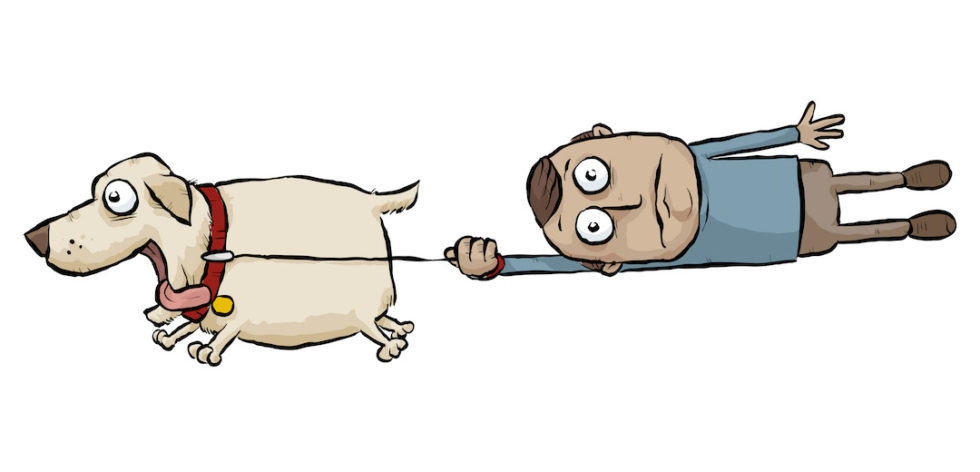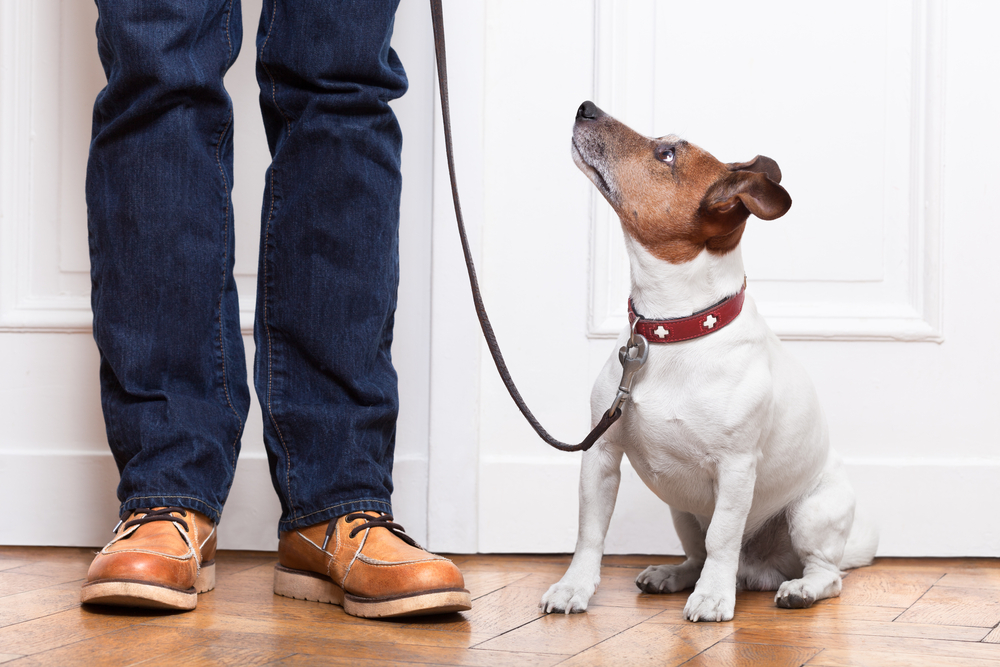So what does all this sitting have to do with walking? A lot, actually!
It puts your dog in a position where he's looking up at you, ready for whatever you do next.
It opens communication between the two of you. You have one sound that you both know the meaning of.
It lets your dog know that when you make sounds, he should pay attention or he might miss out on something. Will you make other sounds that might pay off with more treats? What an exciting person you are!
It makes it very easy to put on the leash when your dog is sitting, rather than prancing around excitedly.
So get that leash and let's get walking!
Oh dear.
Let me back up a little bit.
Your dog is much too excited to listen to you at the beginning of a walk. He's probably been laying around for a good while and is bored, restless, and full of energy. Trying to teach your dog not to pull when he's like this will be frustrating for you both. Burn off some of that rocket fuel first! If you have a yard, go outside and play for a while, doing something your dog enjoys like playing fetch. If you don't have a yard, play inside. One of my tricks is tossing a favorite toy up the stairs, which gives the dog a good workout running up and down, (though this can be hard on the joints so be mindful of puppies or senior dogs). Fifteen minutes to half an hour of off-leash chasing and scampering will take the edge off and make your dog more willing to slow down.
When it's time to put on the leash, don't get your dog jazzed up by saying "Wanna go for a walk? Oh boy! Let's get your leash! Hooray!" and so on. That's just adding fuel to the fire. Be calm and quiet. After the leash is on, have your dog remain sitting while you put on your coat, get your house key, check your phone, or whatever. Just a minute or two will help him get the idea to relax.
Then, taking the leash in both hands (need a refresher on that grip? It's here.) and keeping your dog close, open the door and step outside.
Have him sit while you close the door. Did you bring treats? Now it the perfect time to treat, after he sits.
What if he didn't sit? What if he's dancing around like a fool, jumping and straining and pulling? Then you drag him back into the house, shut the door firmly on the fun outdoors, and ask him again to SIT. Use a strong tone, but don't shout. Say it once and wait. If he's not paying attention then give a check on the leash -- a quick jerk just strong enough to get his attention back on you where it belongs. It's not a punishment; we're not trying to hurt him, but we need to be firm and let him know that this behavior is not acceptable and we'd like him to do something else: SIT.
If he sits, let him know he did right by saying "good" or "thank you" -- mild praise. Then open the door and try again.
We want him to step outside, then sit and wait for you to say it's okay to go on. If you take him out again and he shows no improvement, then take him inside, take off the leash, and do something else, ignoring him. No fun outside walk for him. Don't scold. Don't yell. Don't explain like he could understand. You're not giving any attention to a bad dog who doesn't listen to you. Bad, not-listening dogs don't get the treat of a walk. Bad, not-listening dogs can just sit inside and think about how that certainly did not go the way they thought it would.
And believe me, your dog will be wondering what the heck THAT was all about. Let him stew over it for about ten minutes. Just ignore him. Go polish your shoes or put in some laundry or unload the dishwasher. You're a busy person; got no time for a bad, not-listening dog to drag you around, no sir.
Ten minutes up? Call your dog to you, have him sit, put on the leash, let him relax for that minute or two, and then try again: out the door and sit.
Is he listening better this time?
You may have to repeat this a few times; your dog is learning a few things and he might not get it right away. He's learning that you are in control and the way to get what he wants is to do what you want. Just like he learned that to get a treat, he must sit, he will learn that in order to go on a walk, he must sit when asked.
If he sits, he gets to go forward. Refusal to sit means he doesn't get to go on the walk.
Once your dog is sitting nicely and waiting while you shut the door, Congratulations! You're ready for part five.



No comments:
Post a Comment